Understanding Infection Control in Healthcare Settings
VerifiedAdded on 2020/04/13
|18
|4366
|43
AI Summary
This comprehensive research summary assesses the current state of knowledge and practice regarding infection control among healthcare workers. It evaluates the understanding and implementation of essential infection prevention practices in various healthcare settings. The study identifies notable gaps in knowledge related to surveillance, risk adjustment, pathogenesis, and infection prevention strategies beyond acute care environments. It also examines the role of fomites as potential vectors for disease transmission, revealing significant shortcomings in awareness and control measures among medical students and professionals. Despite adequate theoretical knowledge about healthcare-associated infections (HAIs), practical implementation remains inadequate, with poor adherence to hand hygiene standards and national guidelines. The evaluation extends to reviewing infection control programs across hospitals, where deficiencies in operational guidelines and prevention strategies are apparent. By highlighting these gaps, the study underscores the urgent need for enhanced education and training initiatives aimed at bolstering healthcare workers' capabilities in effectively managing and preventing infections within clinical environments.
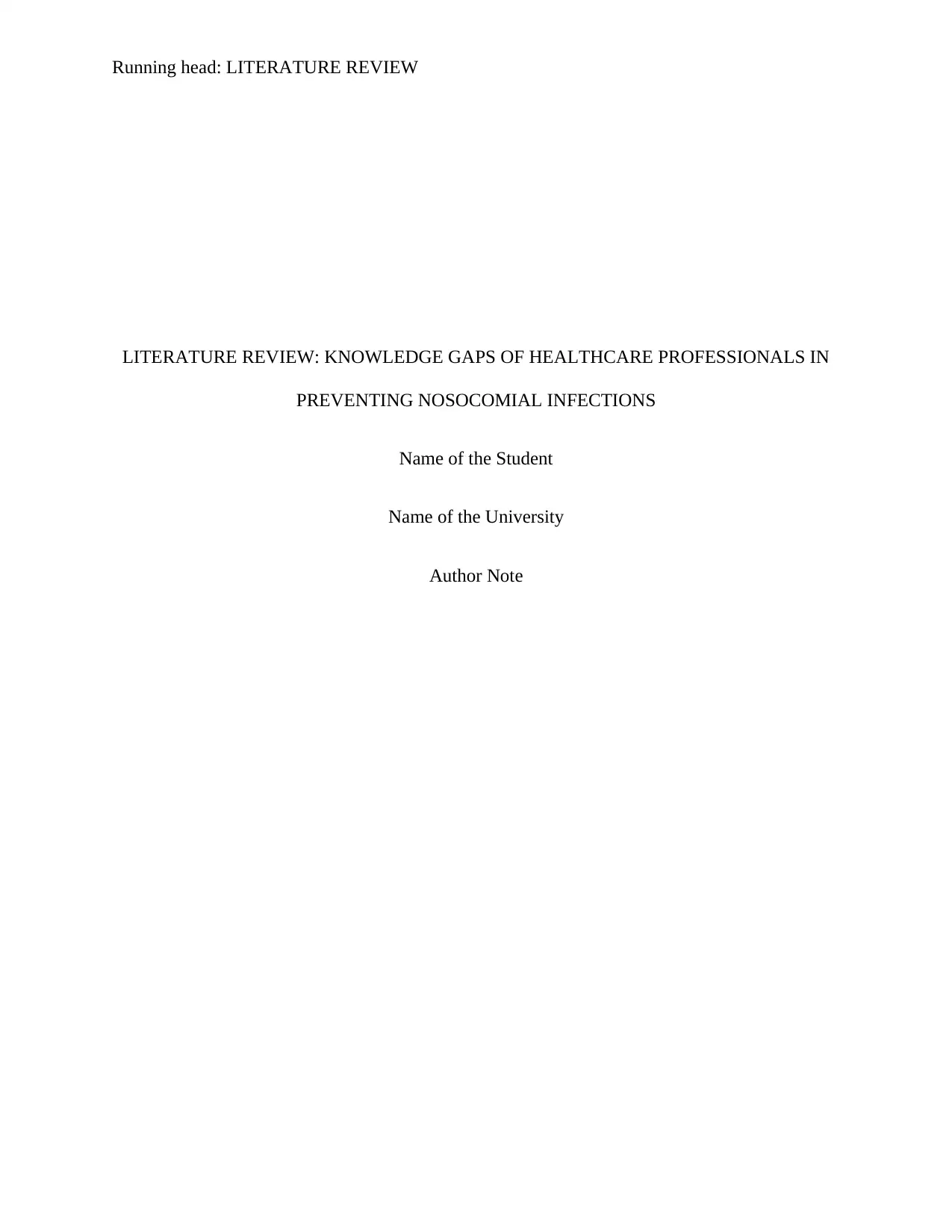
Running head: LITERATURE REVIEW
LITERATURE REVIEW: KNOWLEDGE GAPS OF HEALTHCARE PROFESSIONALS IN
PREVENTING NOSOCOMIAL INFECTIONS
Name of the Student
Name of the University
Author Note
LITERATURE REVIEW: KNOWLEDGE GAPS OF HEALTHCARE PROFESSIONALS IN
PREVENTING NOSOCOMIAL INFECTIONS
Name of the Student
Name of the University
Author Note
Paraphrase This Document
Need a fresh take? Get an instant paraphrase of this document with our AI Paraphraser
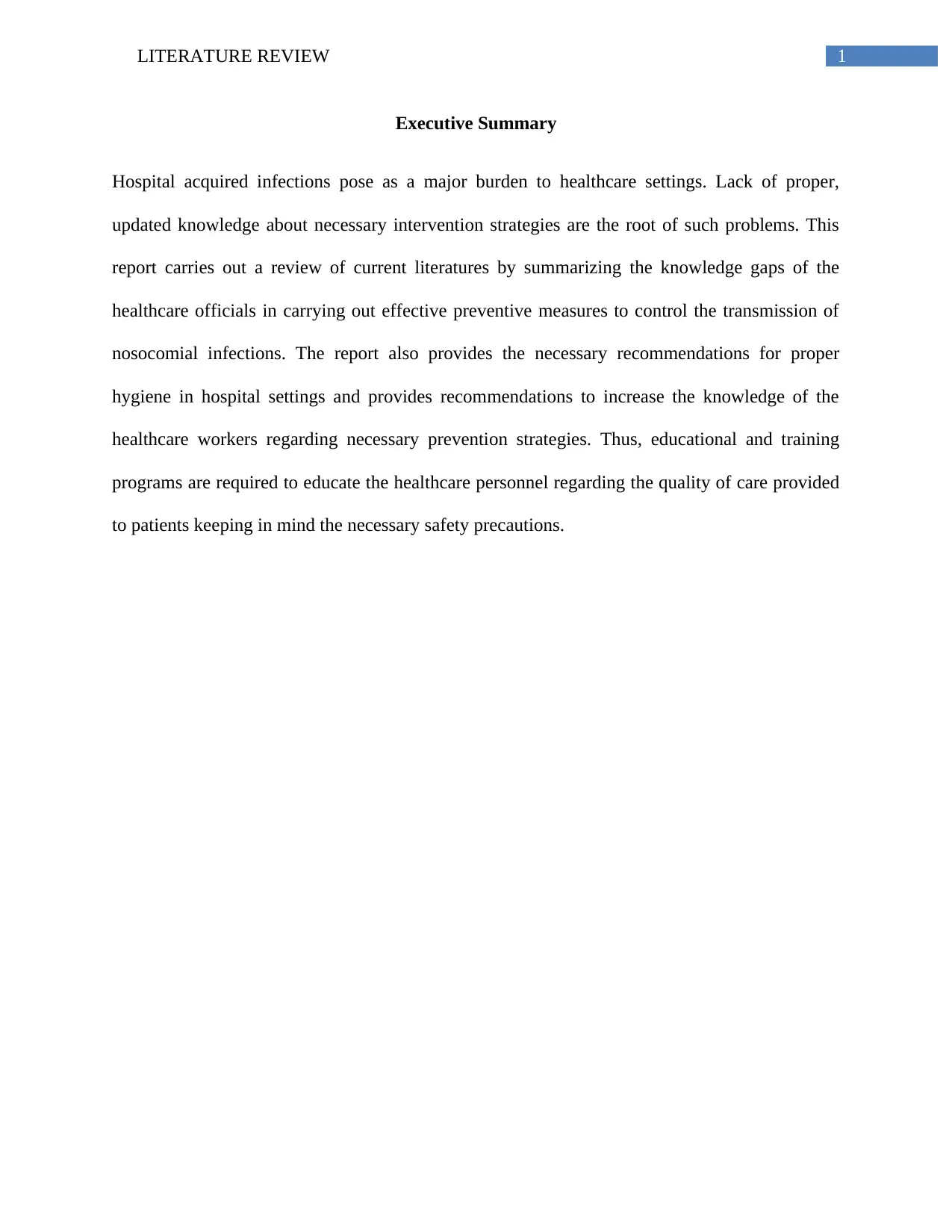
1LITERATURE REVIEW
Executive Summary
Hospital acquired infections pose as a major burden to healthcare settings. Lack of proper,
updated knowledge about necessary intervention strategies are the root of such problems. This
report carries out a review of current literatures by summarizing the knowledge gaps of the
healthcare officials in carrying out effective preventive measures to control the transmission of
nosocomial infections. The report also provides the necessary recommendations for proper
hygiene in hospital settings and provides recommendations to increase the knowledge of the
healthcare workers regarding necessary prevention strategies. Thus, educational and training
programs are required to educate the healthcare personnel regarding the quality of care provided
to patients keeping in mind the necessary safety precautions.
Executive Summary
Hospital acquired infections pose as a major burden to healthcare settings. Lack of proper,
updated knowledge about necessary intervention strategies are the root of such problems. This
report carries out a review of current literatures by summarizing the knowledge gaps of the
healthcare officials in carrying out effective preventive measures to control the transmission of
nosocomial infections. The report also provides the necessary recommendations for proper
hygiene in hospital settings and provides recommendations to increase the knowledge of the
healthcare workers regarding necessary prevention strategies. Thus, educational and training
programs are required to educate the healthcare personnel regarding the quality of care provided
to patients keeping in mind the necessary safety precautions.
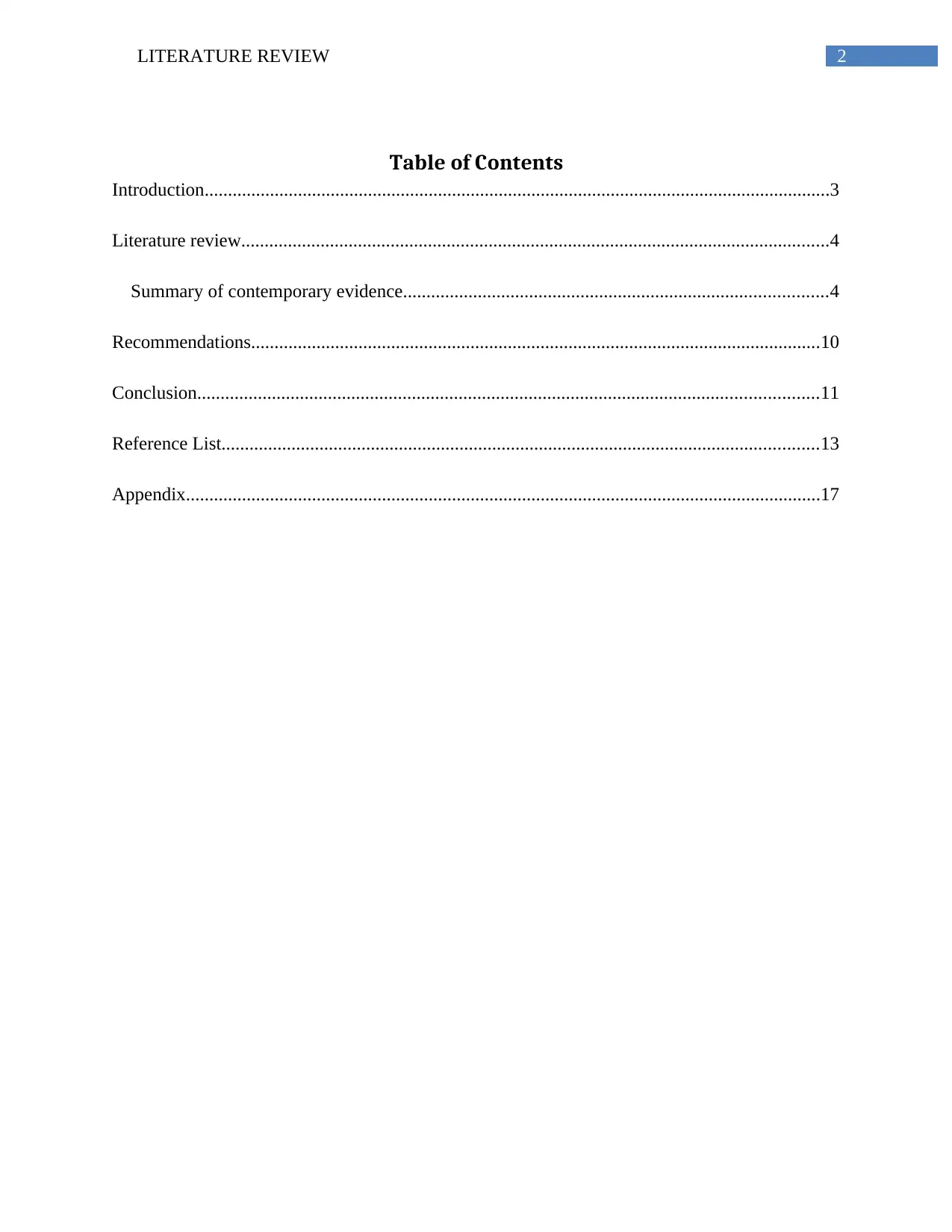
2LITERATURE REVIEW
Table of Contents
Introduction......................................................................................................................................3
Literature review..............................................................................................................................4
Summary of contemporary evidence...........................................................................................4
Recommendations..........................................................................................................................10
Conclusion.....................................................................................................................................11
Reference List................................................................................................................................13
Appendix........................................................................................................................................17
Table of Contents
Introduction......................................................................................................................................3
Literature review..............................................................................................................................4
Summary of contemporary evidence...........................................................................................4
Recommendations..........................................................................................................................10
Conclusion.....................................................................................................................................11
Reference List................................................................................................................................13
Appendix........................................................................................................................................17
⊘ This is a preview!⊘
Do you want full access?
Subscribe today to unlock all pages.

Trusted by 1+ million students worldwide
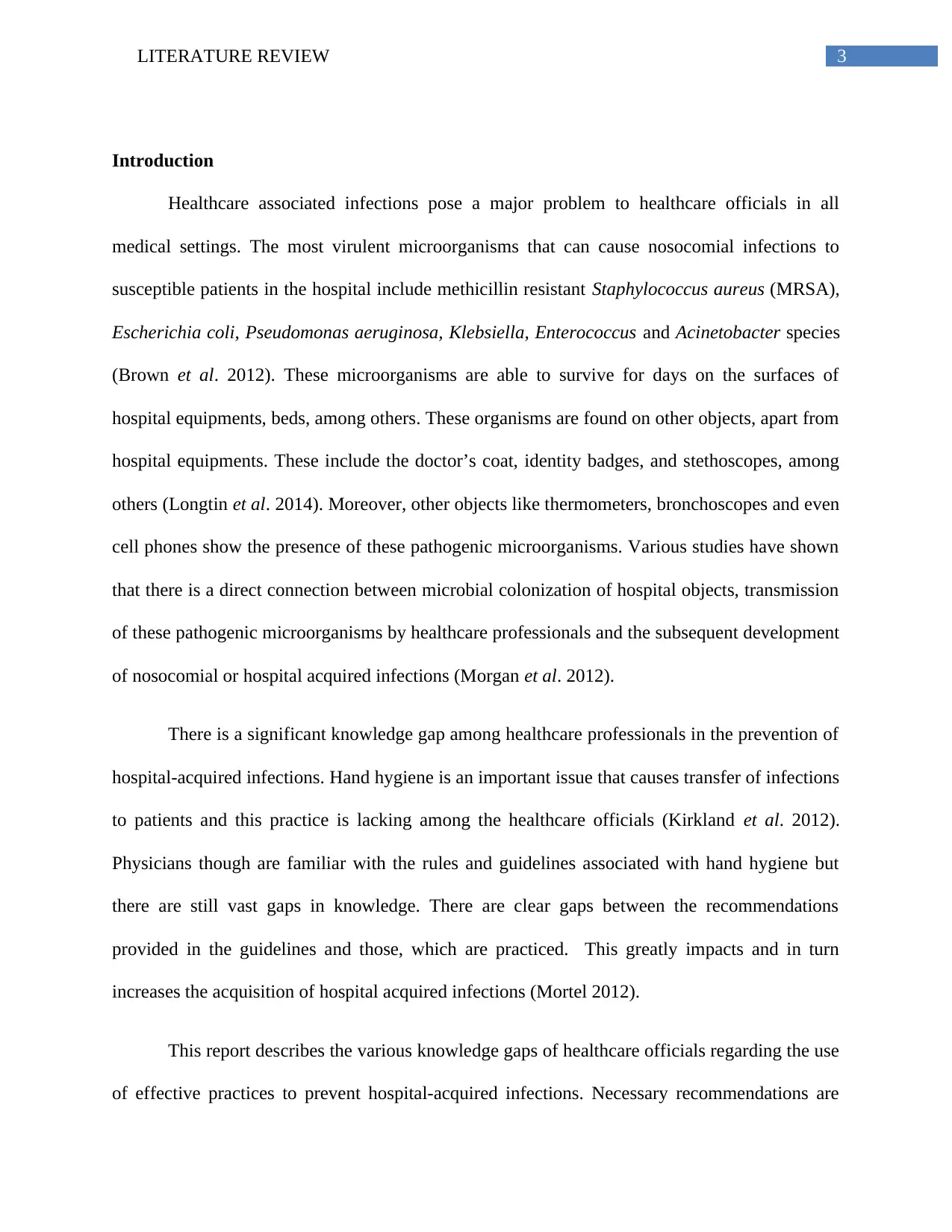
3LITERATURE REVIEW
Introduction
Healthcare associated infections pose a major problem to healthcare officials in all
medical settings. The most virulent microorganisms that can cause nosocomial infections to
susceptible patients in the hospital include methicillin resistant Staphylococcus aureus (MRSA),
Escherichia coli, Pseudomonas aeruginosa, Klebsiella, Enterococcus and Acinetobacter species
(Brown et al. 2012). These microorganisms are able to survive for days on the surfaces of
hospital equipments, beds, among others. These organisms are found on other objects, apart from
hospital equipments. These include the doctor’s coat, identity badges, and stethoscopes, among
others (Longtin et al. 2014). Moreover, other objects like thermometers, bronchoscopes and even
cell phones show the presence of these pathogenic microorganisms. Various studies have shown
that there is a direct connection between microbial colonization of hospital objects, transmission
of these pathogenic microorganisms by healthcare professionals and the subsequent development
of nosocomial or hospital acquired infections (Morgan et al. 2012).
There is a significant knowledge gap among healthcare professionals in the prevention of
hospital-acquired infections. Hand hygiene is an important issue that causes transfer of infections
to patients and this practice is lacking among the healthcare officials (Kirkland et al. 2012).
Physicians though are familiar with the rules and guidelines associated with hand hygiene but
there are still vast gaps in knowledge. There are clear gaps between the recommendations
provided in the guidelines and those, which are practiced. This greatly impacts and in turn
increases the acquisition of hospital acquired infections (Mortel 2012).
This report describes the various knowledge gaps of healthcare officials regarding the use
of effective practices to prevent hospital-acquired infections. Necessary recommendations are
Introduction
Healthcare associated infections pose a major problem to healthcare officials in all
medical settings. The most virulent microorganisms that can cause nosocomial infections to
susceptible patients in the hospital include methicillin resistant Staphylococcus aureus (MRSA),
Escherichia coli, Pseudomonas aeruginosa, Klebsiella, Enterococcus and Acinetobacter species
(Brown et al. 2012). These microorganisms are able to survive for days on the surfaces of
hospital equipments, beds, among others. These organisms are found on other objects, apart from
hospital equipments. These include the doctor’s coat, identity badges, and stethoscopes, among
others (Longtin et al. 2014). Moreover, other objects like thermometers, bronchoscopes and even
cell phones show the presence of these pathogenic microorganisms. Various studies have shown
that there is a direct connection between microbial colonization of hospital objects, transmission
of these pathogenic microorganisms by healthcare professionals and the subsequent development
of nosocomial or hospital acquired infections (Morgan et al. 2012).
There is a significant knowledge gap among healthcare professionals in the prevention of
hospital-acquired infections. Hand hygiene is an important issue that causes transfer of infections
to patients and this practice is lacking among the healthcare officials (Kirkland et al. 2012).
Physicians though are familiar with the rules and guidelines associated with hand hygiene but
there are still vast gaps in knowledge. There are clear gaps between the recommendations
provided in the guidelines and those, which are practiced. This greatly impacts and in turn
increases the acquisition of hospital acquired infections (Mortel 2012).
This report describes the various knowledge gaps of healthcare officials regarding the use
of effective practices to prevent hospital-acquired infections. Necessary recommendations are
Paraphrase This Document
Need a fresh take? Get an instant paraphrase of this document with our AI Paraphraser
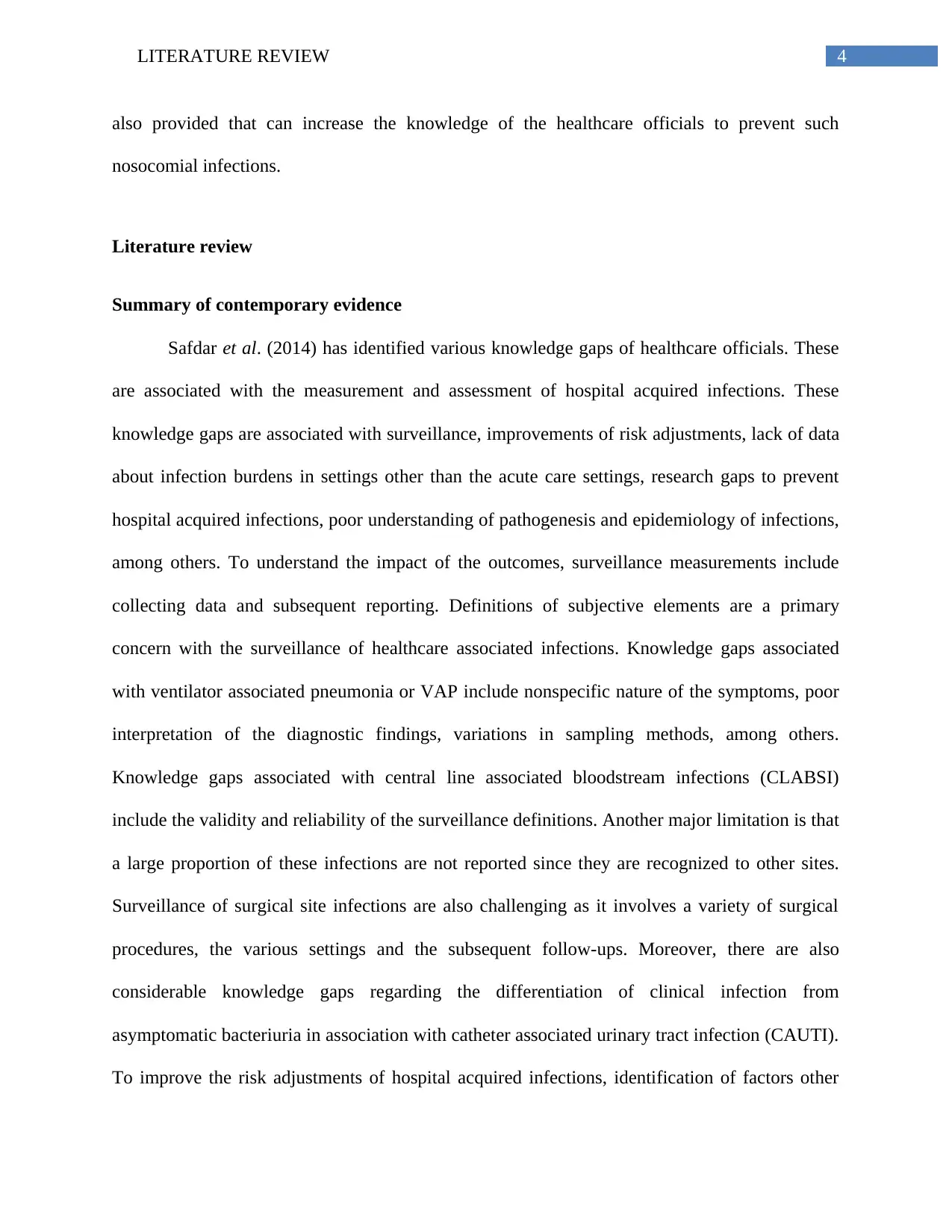
4LITERATURE REVIEW
also provided that can increase the knowledge of the healthcare officials to prevent such
nosocomial infections.
Literature review
Summary of contemporary evidence
Safdar et al. (2014) has identified various knowledge gaps of healthcare officials. These
are associated with the measurement and assessment of hospital acquired infections. These
knowledge gaps are associated with surveillance, improvements of risk adjustments, lack of data
about infection burdens in settings other than the acute care settings, research gaps to prevent
hospital acquired infections, poor understanding of pathogenesis and epidemiology of infections,
among others. To understand the impact of the outcomes, surveillance measurements include
collecting data and subsequent reporting. Definitions of subjective elements are a primary
concern with the surveillance of healthcare associated infections. Knowledge gaps associated
with ventilator associated pneumonia or VAP include nonspecific nature of the symptoms, poor
interpretation of the diagnostic findings, variations in sampling methods, among others.
Knowledge gaps associated with central line associated bloodstream infections (CLABSI)
include the validity and reliability of the surveillance definitions. Another major limitation is that
a large proportion of these infections are not reported since they are recognized to other sites.
Surveillance of surgical site infections are also challenging as it involves a variety of surgical
procedures, the various settings and the subsequent follow-ups. Moreover, there are also
considerable knowledge gaps regarding the differentiation of clinical infection from
asymptomatic bacteriuria in association with catheter associated urinary tract infection (CAUTI).
To improve the risk adjustments of hospital acquired infections, identification of factors other
also provided that can increase the knowledge of the healthcare officials to prevent such
nosocomial infections.
Literature review
Summary of contemporary evidence
Safdar et al. (2014) has identified various knowledge gaps of healthcare officials. These
are associated with the measurement and assessment of hospital acquired infections. These
knowledge gaps are associated with surveillance, improvements of risk adjustments, lack of data
about infection burdens in settings other than the acute care settings, research gaps to prevent
hospital acquired infections, poor understanding of pathogenesis and epidemiology of infections,
among others. To understand the impact of the outcomes, surveillance measurements include
collecting data and subsequent reporting. Definitions of subjective elements are a primary
concern with the surveillance of healthcare associated infections. Knowledge gaps associated
with ventilator associated pneumonia or VAP include nonspecific nature of the symptoms, poor
interpretation of the diagnostic findings, variations in sampling methods, among others.
Knowledge gaps associated with central line associated bloodstream infections (CLABSI)
include the validity and reliability of the surveillance definitions. Another major limitation is that
a large proportion of these infections are not reported since they are recognized to other sites.
Surveillance of surgical site infections are also challenging as it involves a variety of surgical
procedures, the various settings and the subsequent follow-ups. Moreover, there are also
considerable knowledge gaps regarding the differentiation of clinical infection from
asymptomatic bacteriuria in association with catheter associated urinary tract infection (CAUTI).
To improve the risk adjustments of hospital acquired infections, identification of factors other
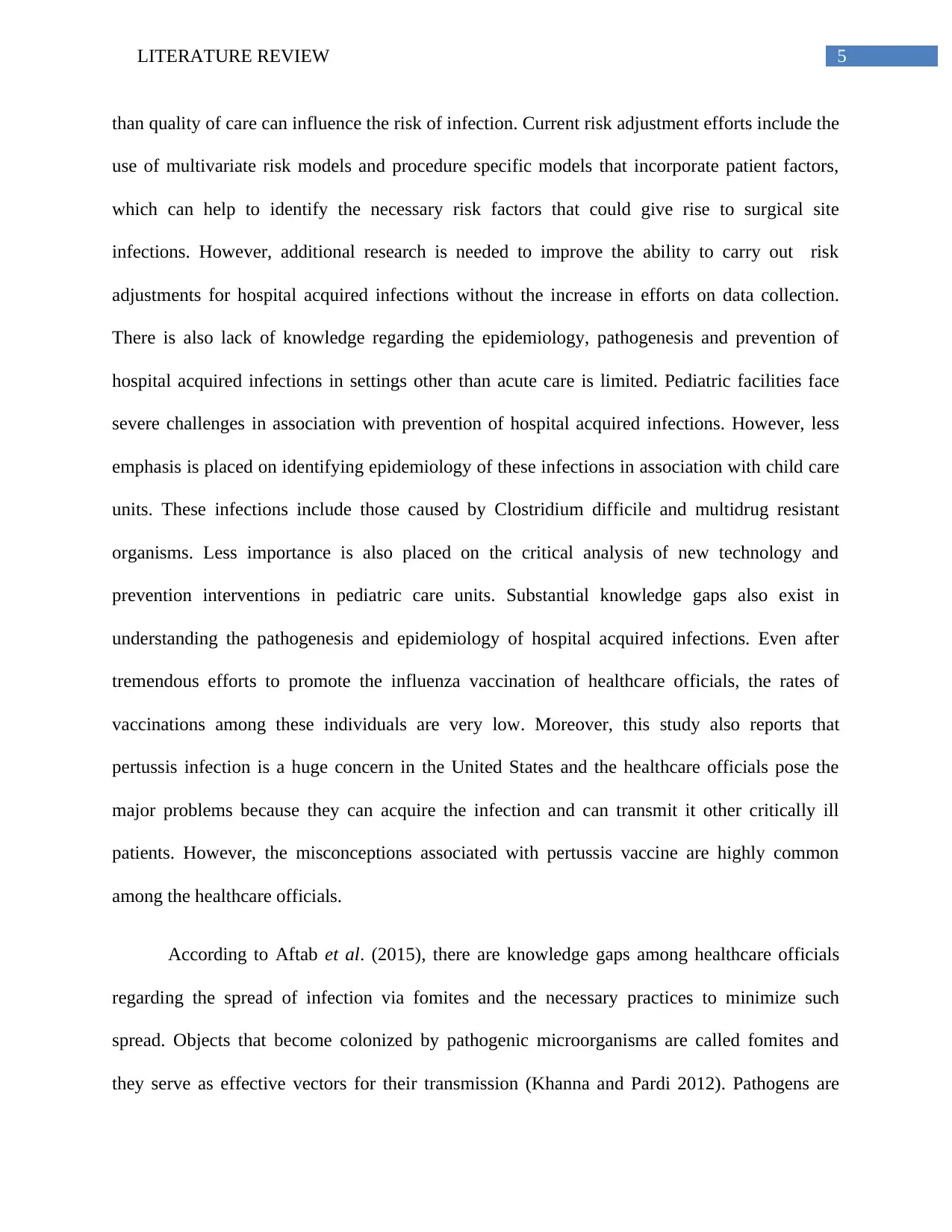
5LITERATURE REVIEW
than quality of care can influence the risk of infection. Current risk adjustment efforts include the
use of multivariate risk models and procedure specific models that incorporate patient factors,
which can help to identify the necessary risk factors that could give rise to surgical site
infections. However, additional research is needed to improve the ability to carry out risk
adjustments for hospital acquired infections without the increase in efforts on data collection.
There is also lack of knowledge regarding the epidemiology, pathogenesis and prevention of
hospital acquired infections in settings other than acute care is limited. Pediatric facilities face
severe challenges in association with prevention of hospital acquired infections. However, less
emphasis is placed on identifying epidemiology of these infections in association with child care
units. These infections include those caused by Clostridium difficile and multidrug resistant
organisms. Less importance is also placed on the critical analysis of new technology and
prevention interventions in pediatric care units. Substantial knowledge gaps also exist in
understanding the pathogenesis and epidemiology of hospital acquired infections. Even after
tremendous efforts to promote the influenza vaccination of healthcare officials, the rates of
vaccinations among these individuals are very low. Moreover, this study also reports that
pertussis infection is a huge concern in the United States and the healthcare officials pose the
major problems because they can acquire the infection and can transmit it other critically ill
patients. However, the misconceptions associated with pertussis vaccine are highly common
among the healthcare officials.
According to Aftab et al. (2015), there are knowledge gaps among healthcare officials
regarding the spread of infection via fomites and the necessary practices to minimize such
spread. Objects that become colonized by pathogenic microorganisms are called fomites and
they serve as effective vectors for their transmission (Khanna and Pardi 2012). Pathogens are
than quality of care can influence the risk of infection. Current risk adjustment efforts include the
use of multivariate risk models and procedure specific models that incorporate patient factors,
which can help to identify the necessary risk factors that could give rise to surgical site
infections. However, additional research is needed to improve the ability to carry out risk
adjustments for hospital acquired infections without the increase in efforts on data collection.
There is also lack of knowledge regarding the epidemiology, pathogenesis and prevention of
hospital acquired infections in settings other than acute care is limited. Pediatric facilities face
severe challenges in association with prevention of hospital acquired infections. However, less
emphasis is placed on identifying epidemiology of these infections in association with child care
units. These infections include those caused by Clostridium difficile and multidrug resistant
organisms. Less importance is also placed on the critical analysis of new technology and
prevention interventions in pediatric care units. Substantial knowledge gaps also exist in
understanding the pathogenesis and epidemiology of hospital acquired infections. Even after
tremendous efforts to promote the influenza vaccination of healthcare officials, the rates of
vaccinations among these individuals are very low. Moreover, this study also reports that
pertussis infection is a huge concern in the United States and the healthcare officials pose the
major problems because they can acquire the infection and can transmit it other critically ill
patients. However, the misconceptions associated with pertussis vaccine are highly common
among the healthcare officials.
According to Aftab et al. (2015), there are knowledge gaps among healthcare officials
regarding the spread of infection via fomites and the necessary practices to minimize such
spread. Objects that become colonized by pathogenic microorganisms are called fomites and
they serve as effective vectors for their transmission (Khanna and Pardi 2012). Pathogens are
⊘ This is a preview!⊘
Do you want full access?
Subscribe today to unlock all pages.

Trusted by 1+ million students worldwide
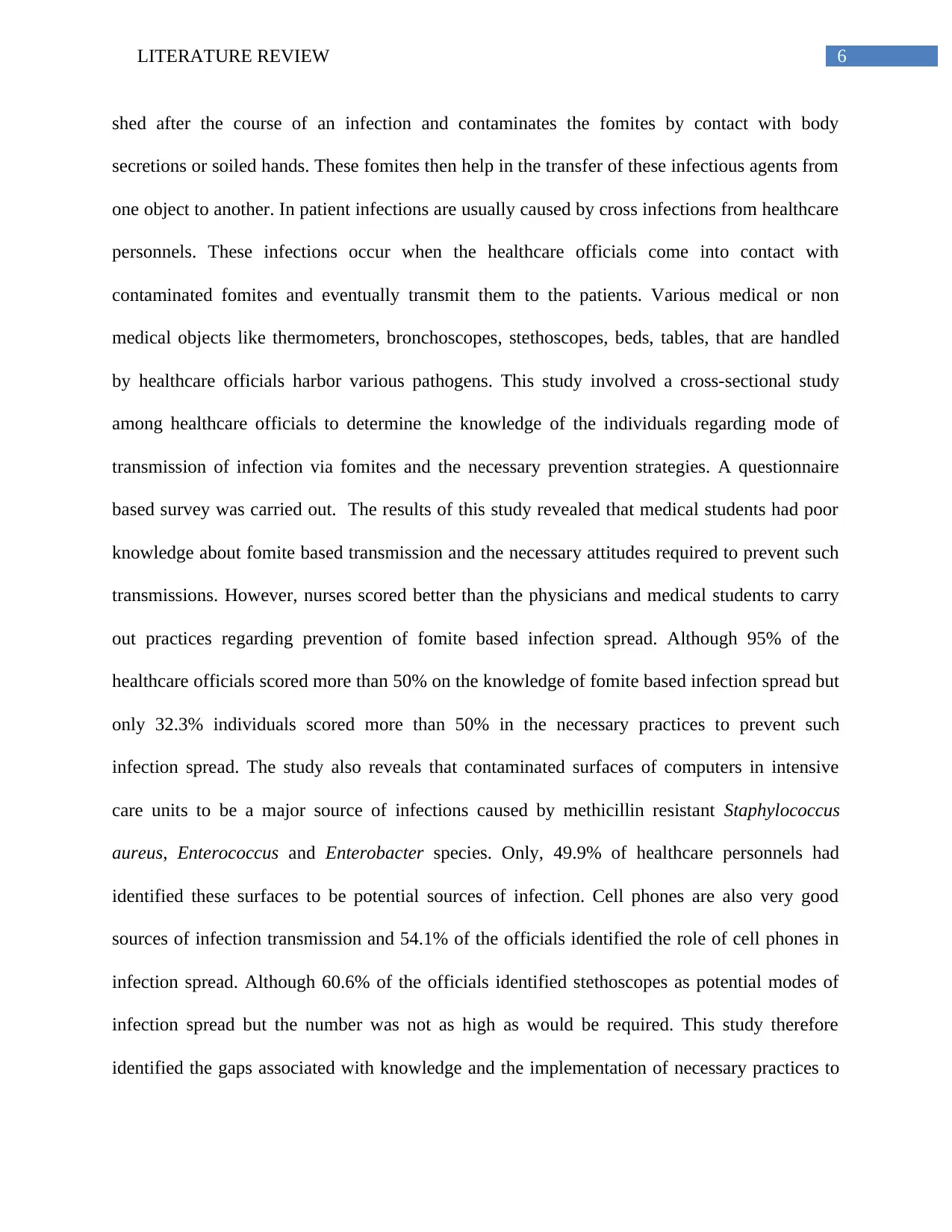
6LITERATURE REVIEW
shed after the course of an infection and contaminates the fomites by contact with body
secretions or soiled hands. These fomites then help in the transfer of these infectious agents from
one object to another. In patient infections are usually caused by cross infections from healthcare
personnels. These infections occur when the healthcare officials come into contact with
contaminated fomites and eventually transmit them to the patients. Various medical or non
medical objects like thermometers, bronchoscopes, stethoscopes, beds, tables, that are handled
by healthcare officials harbor various pathogens. This study involved a cross-sectional study
among healthcare officials to determine the knowledge of the individuals regarding mode of
transmission of infection via fomites and the necessary prevention strategies. A questionnaire
based survey was carried out. The results of this study revealed that medical students had poor
knowledge about fomite based transmission and the necessary attitudes required to prevent such
transmissions. However, nurses scored better than the physicians and medical students to carry
out practices regarding prevention of fomite based infection spread. Although 95% of the
healthcare officials scored more than 50% on the knowledge of fomite based infection spread but
only 32.3% individuals scored more than 50% in the necessary practices to prevent such
infection spread. The study also reveals that contaminated surfaces of computers in intensive
care units to be a major source of infections caused by methicillin resistant Staphylococcus
aureus, Enterococcus and Enterobacter species. Only, 49.9% of healthcare personnels had
identified these surfaces to be potential sources of infection. Cell phones are also very good
sources of infection transmission and 54.1% of the officials identified the role of cell phones in
infection spread. Although 60.6% of the officials identified stethoscopes as potential modes of
infection spread but the number was not as high as would be required. This study therefore
identified the gaps associated with knowledge and the implementation of necessary practices to
shed after the course of an infection and contaminates the fomites by contact with body
secretions or soiled hands. These fomites then help in the transfer of these infectious agents from
one object to another. In patient infections are usually caused by cross infections from healthcare
personnels. These infections occur when the healthcare officials come into contact with
contaminated fomites and eventually transmit them to the patients. Various medical or non
medical objects like thermometers, bronchoscopes, stethoscopes, beds, tables, that are handled
by healthcare officials harbor various pathogens. This study involved a cross-sectional study
among healthcare officials to determine the knowledge of the individuals regarding mode of
transmission of infection via fomites and the necessary prevention strategies. A questionnaire
based survey was carried out. The results of this study revealed that medical students had poor
knowledge about fomite based transmission and the necessary attitudes required to prevent such
transmissions. However, nurses scored better than the physicians and medical students to carry
out practices regarding prevention of fomite based infection spread. Although 95% of the
healthcare officials scored more than 50% on the knowledge of fomite based infection spread but
only 32.3% individuals scored more than 50% in the necessary practices to prevent such
infection spread. The study also reveals that contaminated surfaces of computers in intensive
care units to be a major source of infections caused by methicillin resistant Staphylococcus
aureus, Enterococcus and Enterobacter species. Only, 49.9% of healthcare personnels had
identified these surfaces to be potential sources of infection. Cell phones are also very good
sources of infection transmission and 54.1% of the officials identified the role of cell phones in
infection spread. Although 60.6% of the officials identified stethoscopes as potential modes of
infection spread but the number was not as high as would be required. This study therefore
identified the gaps associated with knowledge and the implementation of necessary practices to
Paraphrase This Document
Need a fresh take? Get an instant paraphrase of this document with our AI Paraphraser
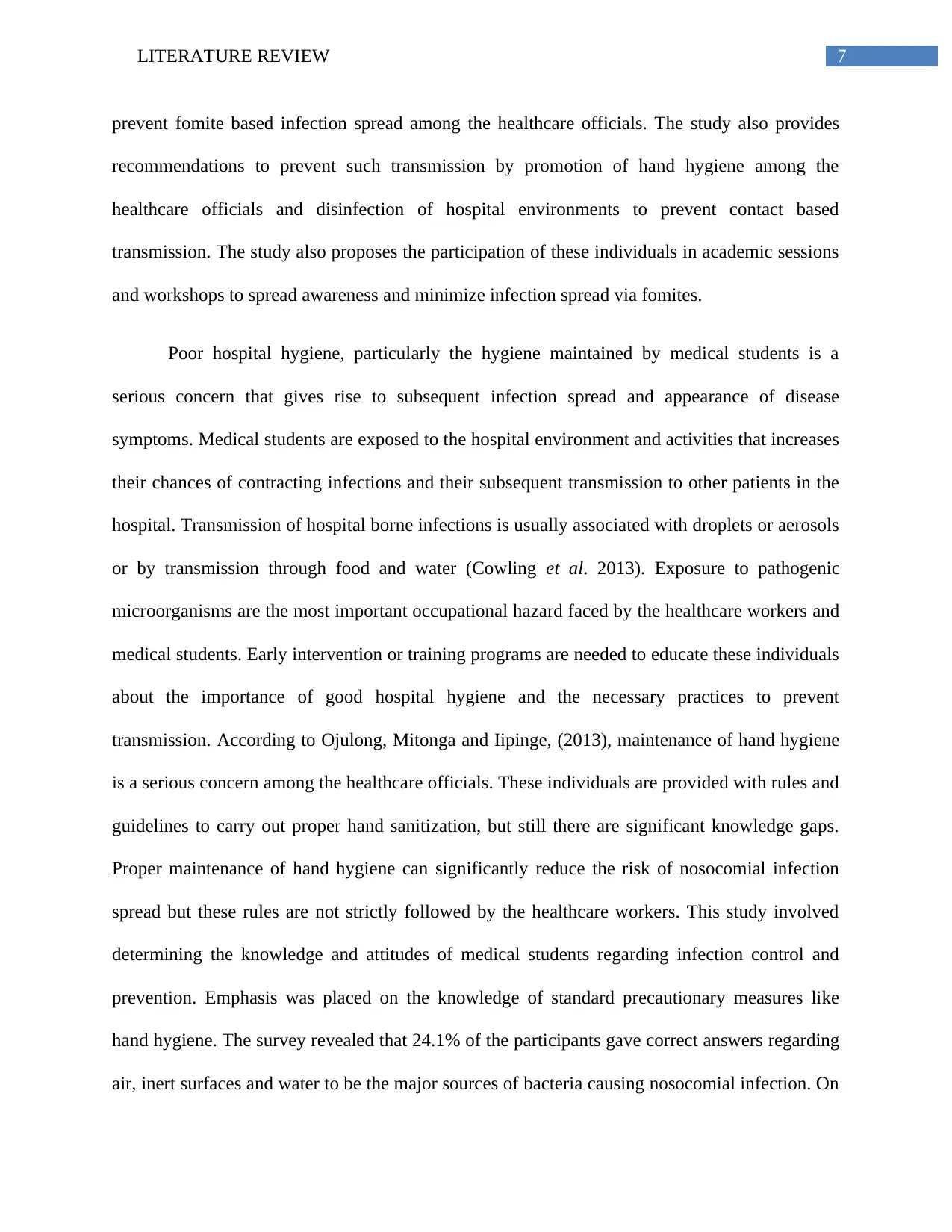
7LITERATURE REVIEW
prevent fomite based infection spread among the healthcare officials. The study also provides
recommendations to prevent such transmission by promotion of hand hygiene among the
healthcare officials and disinfection of hospital environments to prevent contact based
transmission. The study also proposes the participation of these individuals in academic sessions
and workshops to spread awareness and minimize infection spread via fomites.
Poor hospital hygiene, particularly the hygiene maintained by medical students is a
serious concern that gives rise to subsequent infection spread and appearance of disease
symptoms. Medical students are exposed to the hospital environment and activities that increases
their chances of contracting infections and their subsequent transmission to other patients in the
hospital. Transmission of hospital borne infections is usually associated with droplets or aerosols
or by transmission through food and water (Cowling et al. 2013). Exposure to pathogenic
microorganisms are the most important occupational hazard faced by the healthcare workers and
medical students. Early intervention or training programs are needed to educate these individuals
about the importance of good hospital hygiene and the necessary practices to prevent
transmission. According to Ojulong, Mitonga and Iipinge, (2013), maintenance of hand hygiene
is a serious concern among the healthcare officials. These individuals are provided with rules and
guidelines to carry out proper hand sanitization, but still there are significant knowledge gaps.
Proper maintenance of hand hygiene can significantly reduce the risk of nosocomial infection
spread but these rules are not strictly followed by the healthcare workers. This study involved
determining the knowledge and attitudes of medical students regarding infection control and
prevention. Emphasis was placed on the knowledge of standard precautionary measures like
hand hygiene. The survey revealed that 24.1% of the participants gave correct answers regarding
air, inert surfaces and water to be the major sources of bacteria causing nosocomial infection. On
prevent fomite based infection spread among the healthcare officials. The study also provides
recommendations to prevent such transmission by promotion of hand hygiene among the
healthcare officials and disinfection of hospital environments to prevent contact based
transmission. The study also proposes the participation of these individuals in academic sessions
and workshops to spread awareness and minimize infection spread via fomites.
Poor hospital hygiene, particularly the hygiene maintained by medical students is a
serious concern that gives rise to subsequent infection spread and appearance of disease
symptoms. Medical students are exposed to the hospital environment and activities that increases
their chances of contracting infections and their subsequent transmission to other patients in the
hospital. Transmission of hospital borne infections is usually associated with droplets or aerosols
or by transmission through food and water (Cowling et al. 2013). Exposure to pathogenic
microorganisms are the most important occupational hazard faced by the healthcare workers and
medical students. Early intervention or training programs are needed to educate these individuals
about the importance of good hospital hygiene and the necessary practices to prevent
transmission. According to Ojulong, Mitonga and Iipinge, (2013), maintenance of hand hygiene
is a serious concern among the healthcare officials. These individuals are provided with rules and
guidelines to carry out proper hand sanitization, but still there are significant knowledge gaps.
Proper maintenance of hand hygiene can significantly reduce the risk of nosocomial infection
spread but these rules are not strictly followed by the healthcare workers. This study involved
determining the knowledge and attitudes of medical students regarding infection control and
prevention. Emphasis was placed on the knowledge of standard precautionary measures like
hand hygiene. The survey revealed that 24.1% of the participants gave correct answers regarding
air, inert surfaces and water to be the major sources of bacteria causing nosocomial infection. On
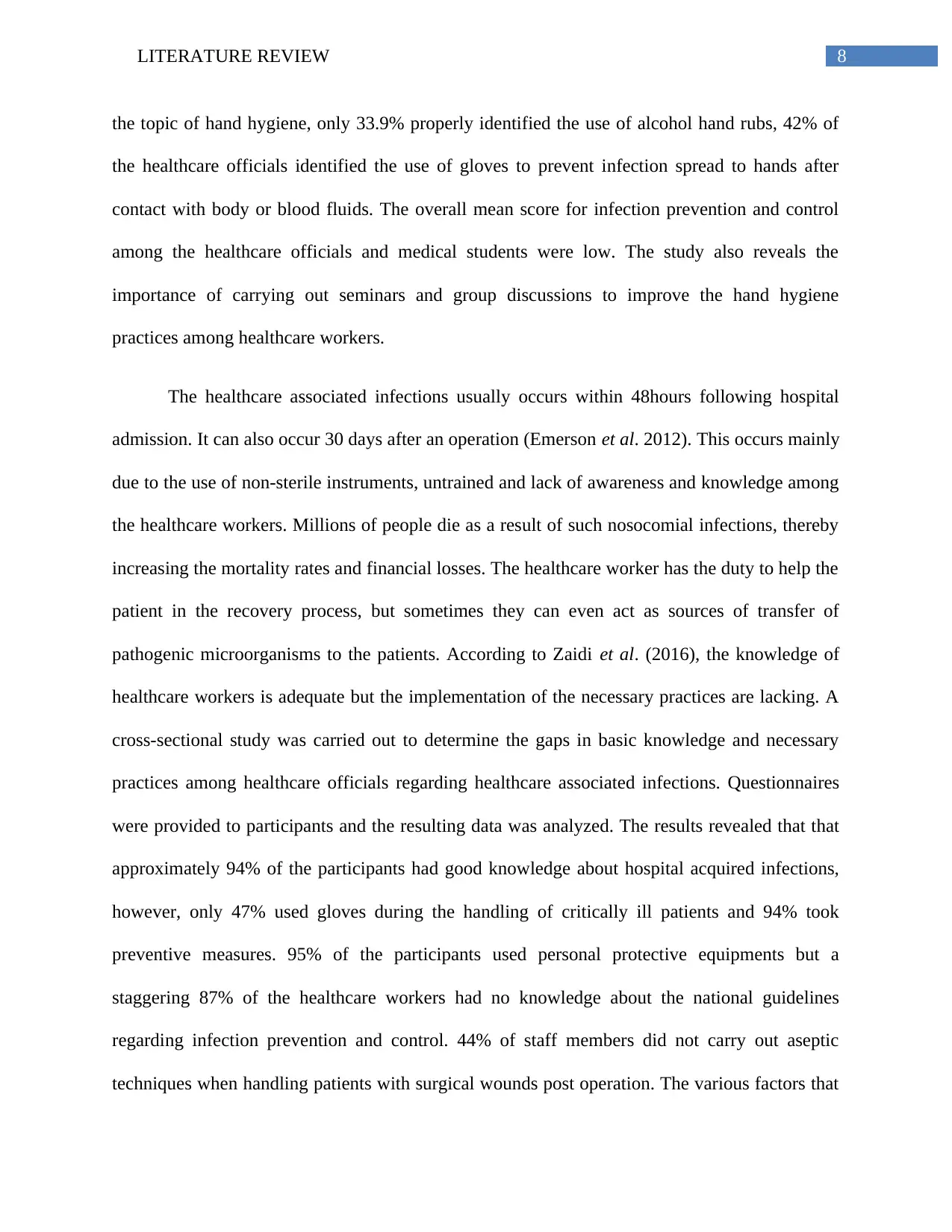
8LITERATURE REVIEW
the topic of hand hygiene, only 33.9% properly identified the use of alcohol hand rubs, 42% of
the healthcare officials identified the use of gloves to prevent infection spread to hands after
contact with body or blood fluids. The overall mean score for infection prevention and control
among the healthcare officials and medical students were low. The study also reveals the
importance of carrying out seminars and group discussions to improve the hand hygiene
practices among healthcare workers.
The healthcare associated infections usually occurs within 48hours following hospital
admission. It can also occur 30 days after an operation (Emerson et al. 2012). This occurs mainly
due to the use of non-sterile instruments, untrained and lack of awareness and knowledge among
the healthcare workers. Millions of people die as a result of such nosocomial infections, thereby
increasing the mortality rates and financial losses. The healthcare worker has the duty to help the
patient in the recovery process, but sometimes they can even act as sources of transfer of
pathogenic microorganisms to the patients. According to Zaidi et al. (2016), the knowledge of
healthcare workers is adequate but the implementation of the necessary practices are lacking. A
cross-sectional study was carried out to determine the gaps in basic knowledge and necessary
practices among healthcare officials regarding healthcare associated infections. Questionnaires
were provided to participants and the resulting data was analyzed. The results revealed that that
approximately 94% of the participants had good knowledge about hospital acquired infections,
however, only 47% used gloves during the handling of critically ill patients and 94% took
preventive measures. 95% of the participants used personal protective equipments but a
staggering 87% of the healthcare workers had no knowledge about the national guidelines
regarding infection prevention and control. 44% of staff members did not carry out aseptic
techniques when handling patients with surgical wounds post operation. The various factors that
the topic of hand hygiene, only 33.9% properly identified the use of alcohol hand rubs, 42% of
the healthcare officials identified the use of gloves to prevent infection spread to hands after
contact with body or blood fluids. The overall mean score for infection prevention and control
among the healthcare officials and medical students were low. The study also reveals the
importance of carrying out seminars and group discussions to improve the hand hygiene
practices among healthcare workers.
The healthcare associated infections usually occurs within 48hours following hospital
admission. It can also occur 30 days after an operation (Emerson et al. 2012). This occurs mainly
due to the use of non-sterile instruments, untrained and lack of awareness and knowledge among
the healthcare workers. Millions of people die as a result of such nosocomial infections, thereby
increasing the mortality rates and financial losses. The healthcare worker has the duty to help the
patient in the recovery process, but sometimes they can even act as sources of transfer of
pathogenic microorganisms to the patients. According to Zaidi et al. (2016), the knowledge of
healthcare workers is adequate but the implementation of the necessary practices are lacking. A
cross-sectional study was carried out to determine the gaps in basic knowledge and necessary
practices among healthcare officials regarding healthcare associated infections. Questionnaires
were provided to participants and the resulting data was analyzed. The results revealed that that
approximately 94% of the participants had good knowledge about hospital acquired infections,
however, only 47% used gloves during the handling of critically ill patients and 94% took
preventive measures. 95% of the participants used personal protective equipments but a
staggering 87% of the healthcare workers had no knowledge about the national guidelines
regarding infection prevention and control. 44% of staff members did not carry out aseptic
techniques when handling patients with surgical wounds post operation. The various factors that
⊘ This is a preview!⊘
Do you want full access?
Subscribe today to unlock all pages.

Trusted by 1+ million students worldwide
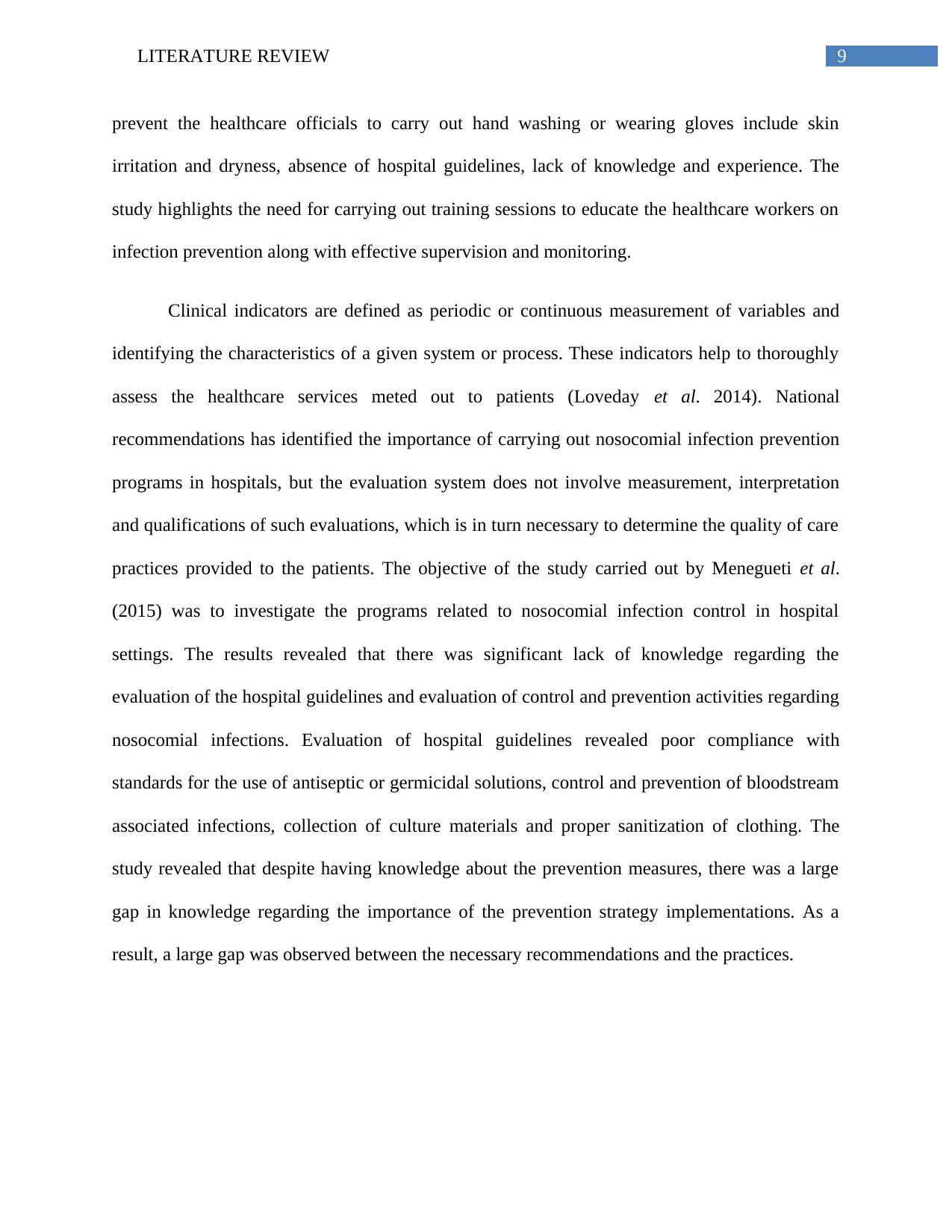
9LITERATURE REVIEW
prevent the healthcare officials to carry out hand washing or wearing gloves include skin
irritation and dryness, absence of hospital guidelines, lack of knowledge and experience. The
study highlights the need for carrying out training sessions to educate the healthcare workers on
infection prevention along with effective supervision and monitoring.
Clinical indicators are defined as periodic or continuous measurement of variables and
identifying the characteristics of a given system or process. These indicators help to thoroughly
assess the healthcare services meted out to patients (Loveday et al. 2014). National
recommendations has identified the importance of carrying out nosocomial infection prevention
programs in hospitals, but the evaluation system does not involve measurement, interpretation
and qualifications of such evaluations, which is in turn necessary to determine the quality of care
practices provided to the patients. The objective of the study carried out by Menegueti et al.
(2015) was to investigate the programs related to nosocomial infection control in hospital
settings. The results revealed that there was significant lack of knowledge regarding the
evaluation of the hospital guidelines and evaluation of control and prevention activities regarding
nosocomial infections. Evaluation of hospital guidelines revealed poor compliance with
standards for the use of antiseptic or germicidal solutions, control and prevention of bloodstream
associated infections, collection of culture materials and proper sanitization of clothing. The
study revealed that despite having knowledge about the prevention measures, there was a large
gap in knowledge regarding the importance of the prevention strategy implementations. As a
result, a large gap was observed between the necessary recommendations and the practices.
prevent the healthcare officials to carry out hand washing or wearing gloves include skin
irritation and dryness, absence of hospital guidelines, lack of knowledge and experience. The
study highlights the need for carrying out training sessions to educate the healthcare workers on
infection prevention along with effective supervision and monitoring.
Clinical indicators are defined as periodic or continuous measurement of variables and
identifying the characteristics of a given system or process. These indicators help to thoroughly
assess the healthcare services meted out to patients (Loveday et al. 2014). National
recommendations has identified the importance of carrying out nosocomial infection prevention
programs in hospitals, but the evaluation system does not involve measurement, interpretation
and qualifications of such evaluations, which is in turn necessary to determine the quality of care
practices provided to the patients. The objective of the study carried out by Menegueti et al.
(2015) was to investigate the programs related to nosocomial infection control in hospital
settings. The results revealed that there was significant lack of knowledge regarding the
evaluation of the hospital guidelines and evaluation of control and prevention activities regarding
nosocomial infections. Evaluation of hospital guidelines revealed poor compliance with
standards for the use of antiseptic or germicidal solutions, control and prevention of bloodstream
associated infections, collection of culture materials and proper sanitization of clothing. The
study revealed that despite having knowledge about the prevention measures, there was a large
gap in knowledge regarding the importance of the prevention strategy implementations. As a
result, a large gap was observed between the necessary recommendations and the practices.
Paraphrase This Document
Need a fresh take? Get an instant paraphrase of this document with our AI Paraphraser
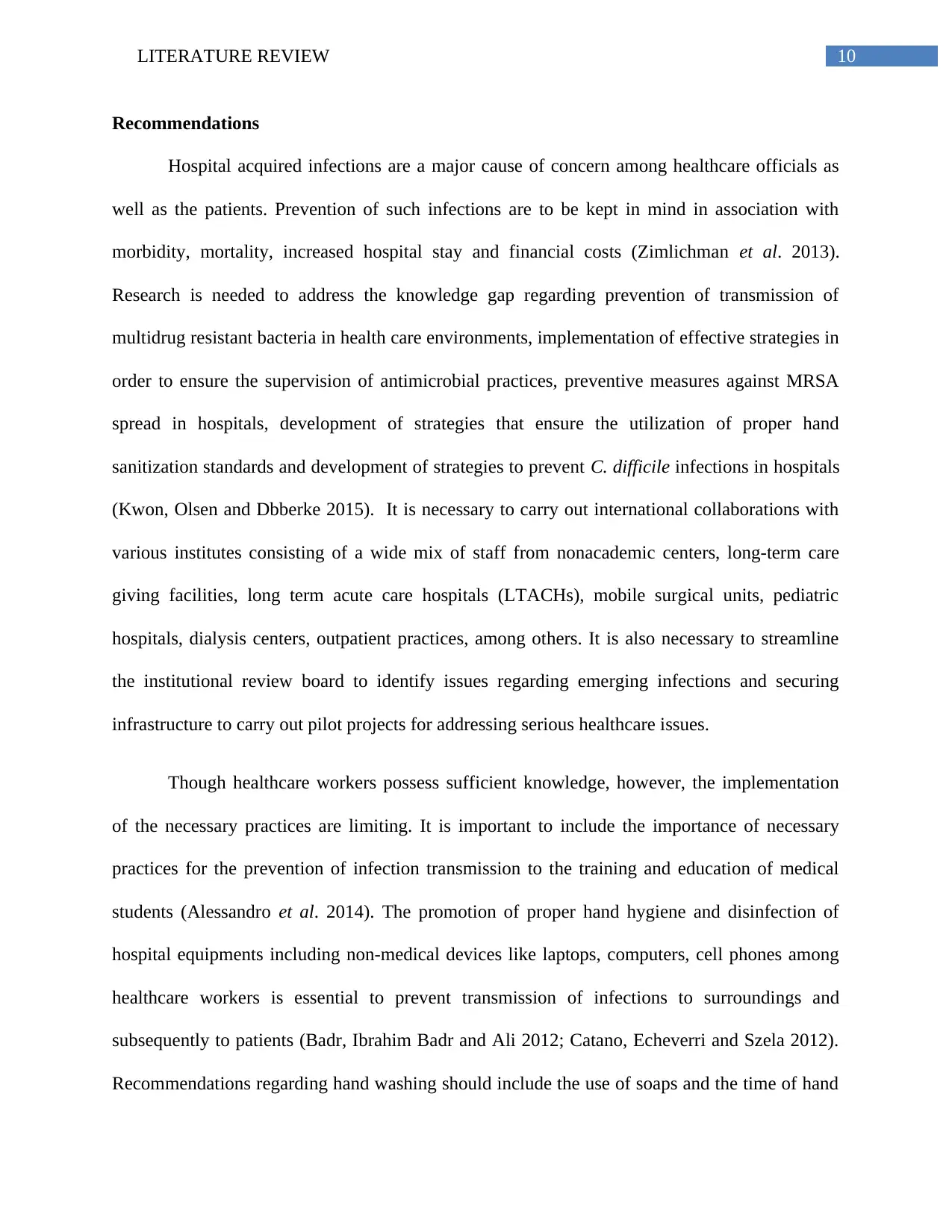
10LITERATURE REVIEW
Recommendations
Hospital acquired infections are a major cause of concern among healthcare officials as
well as the patients. Prevention of such infections are to be kept in mind in association with
morbidity, mortality, increased hospital stay and financial costs (Zimlichman et al. 2013).
Research is needed to address the knowledge gap regarding prevention of transmission of
multidrug resistant bacteria in health care environments, implementation of effective strategies in
order to ensure the supervision of antimicrobial practices, preventive measures against MRSA
spread in hospitals, development of strategies that ensure the utilization of proper hand
sanitization standards and development of strategies to prevent C. difficile infections in hospitals
(Kwon, Olsen and Dbberke 2015). It is necessary to carry out international collaborations with
various institutes consisting of a wide mix of staff from nonacademic centers, long-term care
giving facilities, long term acute care hospitals (LTACHs), mobile surgical units, pediatric
hospitals, dialysis centers, outpatient practices, among others. It is also necessary to streamline
the institutional review board to identify issues regarding emerging infections and securing
infrastructure to carry out pilot projects for addressing serious healthcare issues.
Though healthcare workers possess sufficient knowledge, however, the implementation
of the necessary practices are limiting. It is important to include the importance of necessary
practices for the prevention of infection transmission to the training and education of medical
students (Alessandro et al. 2014). The promotion of proper hand hygiene and disinfection of
hospital equipments including non-medical devices like laptops, computers, cell phones among
healthcare workers is essential to prevent transmission of infections to surroundings and
subsequently to patients (Badr, Ibrahim Badr and Ali 2012; Catano, Echeverri and Szela 2012).
Recommendations regarding hand washing should include the use of soaps and the time of hand
Recommendations
Hospital acquired infections are a major cause of concern among healthcare officials as
well as the patients. Prevention of such infections are to be kept in mind in association with
morbidity, mortality, increased hospital stay and financial costs (Zimlichman et al. 2013).
Research is needed to address the knowledge gap regarding prevention of transmission of
multidrug resistant bacteria in health care environments, implementation of effective strategies in
order to ensure the supervision of antimicrobial practices, preventive measures against MRSA
spread in hospitals, development of strategies that ensure the utilization of proper hand
sanitization standards and development of strategies to prevent C. difficile infections in hospitals
(Kwon, Olsen and Dbberke 2015). It is necessary to carry out international collaborations with
various institutes consisting of a wide mix of staff from nonacademic centers, long-term care
giving facilities, long term acute care hospitals (LTACHs), mobile surgical units, pediatric
hospitals, dialysis centers, outpatient practices, among others. It is also necessary to streamline
the institutional review board to identify issues regarding emerging infections and securing
infrastructure to carry out pilot projects for addressing serious healthcare issues.
Though healthcare workers possess sufficient knowledge, however, the implementation
of the necessary practices are limiting. It is important to include the importance of necessary
practices for the prevention of infection transmission to the training and education of medical
students (Alessandro et al. 2014). The promotion of proper hand hygiene and disinfection of
hospital equipments including non-medical devices like laptops, computers, cell phones among
healthcare workers is essential to prevent transmission of infections to surroundings and
subsequently to patients (Badr, Ibrahim Badr and Ali 2012; Catano, Echeverri and Szela 2012).
Recommendations regarding hand washing should include the use of soaps and the time of hand
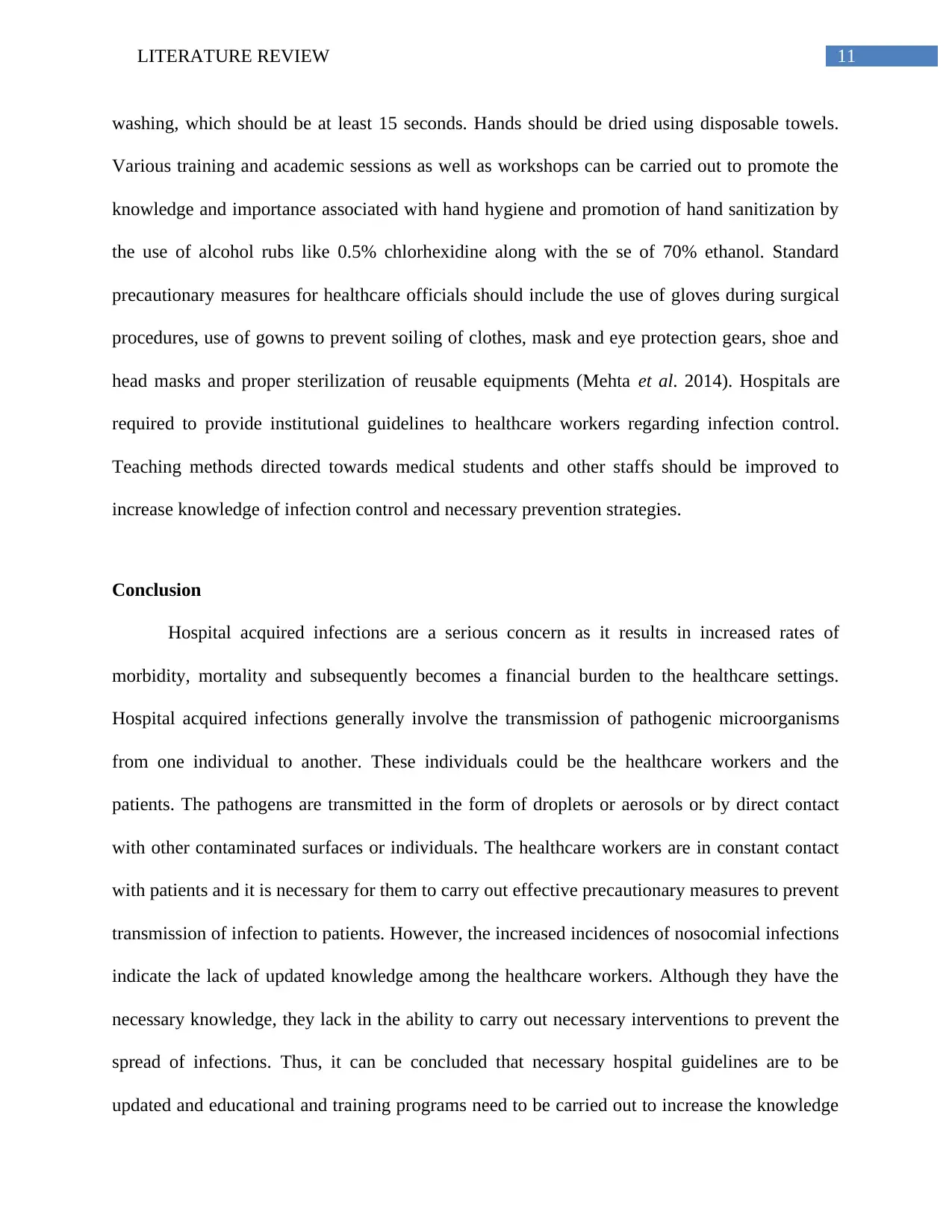
11LITERATURE REVIEW
washing, which should be at least 15 seconds. Hands should be dried using disposable towels.
Various training and academic sessions as well as workshops can be carried out to promote the
knowledge and importance associated with hand hygiene and promotion of hand sanitization by
the use of alcohol rubs like 0.5% chlorhexidine along with the se of 70% ethanol. Standard
precautionary measures for healthcare officials should include the use of gloves during surgical
procedures, use of gowns to prevent soiling of clothes, mask and eye protection gears, shoe and
head masks and proper sterilization of reusable equipments (Mehta et al. 2014). Hospitals are
required to provide institutional guidelines to healthcare workers regarding infection control.
Teaching methods directed towards medical students and other staffs should be improved to
increase knowledge of infection control and necessary prevention strategies.
Conclusion
Hospital acquired infections are a serious concern as it results in increased rates of
morbidity, mortality and subsequently becomes a financial burden to the healthcare settings.
Hospital acquired infections generally involve the transmission of pathogenic microorganisms
from one individual to another. These individuals could be the healthcare workers and the
patients. The pathogens are transmitted in the form of droplets or aerosols or by direct contact
with other contaminated surfaces or individuals. The healthcare workers are in constant contact
with patients and it is necessary for them to carry out effective precautionary measures to prevent
transmission of infection to patients. However, the increased incidences of nosocomial infections
indicate the lack of updated knowledge among the healthcare workers. Although they have the
necessary knowledge, they lack in the ability to carry out necessary interventions to prevent the
spread of infections. Thus, it can be concluded that necessary hospital guidelines are to be
updated and educational and training programs need to be carried out to increase the knowledge
washing, which should be at least 15 seconds. Hands should be dried using disposable towels.
Various training and academic sessions as well as workshops can be carried out to promote the
knowledge and importance associated with hand hygiene and promotion of hand sanitization by
the use of alcohol rubs like 0.5% chlorhexidine along with the se of 70% ethanol. Standard
precautionary measures for healthcare officials should include the use of gloves during surgical
procedures, use of gowns to prevent soiling of clothes, mask and eye protection gears, shoe and
head masks and proper sterilization of reusable equipments (Mehta et al. 2014). Hospitals are
required to provide institutional guidelines to healthcare workers regarding infection control.
Teaching methods directed towards medical students and other staffs should be improved to
increase knowledge of infection control and necessary prevention strategies.
Conclusion
Hospital acquired infections are a serious concern as it results in increased rates of
morbidity, mortality and subsequently becomes a financial burden to the healthcare settings.
Hospital acquired infections generally involve the transmission of pathogenic microorganisms
from one individual to another. These individuals could be the healthcare workers and the
patients. The pathogens are transmitted in the form of droplets or aerosols or by direct contact
with other contaminated surfaces or individuals. The healthcare workers are in constant contact
with patients and it is necessary for them to carry out effective precautionary measures to prevent
transmission of infection to patients. However, the increased incidences of nosocomial infections
indicate the lack of updated knowledge among the healthcare workers. Although they have the
necessary knowledge, they lack in the ability to carry out necessary interventions to prevent the
spread of infections. Thus, it can be concluded that necessary hospital guidelines are to be
updated and educational and training programs need to be carried out to increase the knowledge
⊘ This is a preview!⊘
Do you want full access?
Subscribe today to unlock all pages.

Trusted by 1+ million students worldwide
1 out of 18
Related Documents
Your All-in-One AI-Powered Toolkit for Academic Success.
+13062052269
info@desklib.com
Available 24*7 on WhatsApp / Email
![[object Object]](/_next/static/media/star-bottom.7253800d.svg)
Unlock your academic potential
Copyright © 2020–2025 A2Z Services. All Rights Reserved. Developed and managed by ZUCOL.




